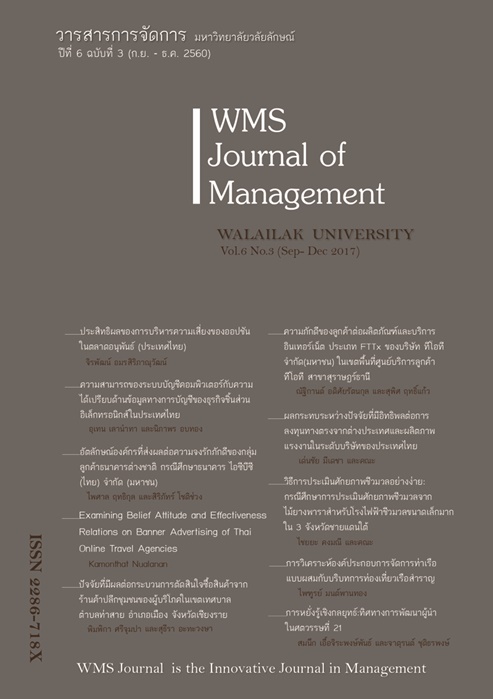Strategic Intuition: The Development of Leader in the 21st Century
Main Article Content
Abstract
Article Details
References
เกรียงไกร เจริญวงศ์ศักดิ์. (2559). ถอดรหัสแนวโน้มใหญ่ของโลกปี 2020: โอกาสและการปรับตัวของธุรกิจในอนาคต. วารสารวิทยาการจัดการ. 3(1), 1-26.
เกรียงศักดิ์ เจริญวงศ์ศักดิ์. (2549). การคิดเชิงกลยุทธ์. กรุงเทพฯ: ซัคเซสมีเดีย.
ไพฑูรย์ สินลารัตน์. (2557). ทักษะแห่งศตวรรษที่ 21 : ต้องก้าวให้พ้นกับดักของตะวันตก. กรุงเทพฯ: โรงพิมพ์แห่งจุฬาลงกรณ์มหาวิทยาลัย.
ปกรณ์ ปรียากร. (2544). การวางแผนกลยุทธ์-แนวคิดและแนวทางเชิงประยุกต์. กรุงเทพฯ: เสมาธรรม.
ธัญวิทย์ ศรีจันทร์, สิริฉันท์ สถิรกุล เตชพาหพงษ์ และ ปทีป เมธาคุณวุฒิ. (2559). การวิเคราะห์องค์ประกอบคุณลักษณะภาวะผู้นำในศตวรรษที่ 21 ของกรรมการองค์กรนิสิตนักศึกษา. วารสารวิธีวิทยาการวิจัย. 29(2), 1-17.
ประพนธ์ ผาสุขยืด. (2549). Intuition ปัญญาญาณ. (พิมพ์ครั้งที่6). กรุงเทพฯ: ใยไหม.
สุดใจ วันอุดมเดชาชัย. (2556). การจัดการเชิงกลยุทธ์. กรุงเทพฯ: สามลดา.
Brown, S.L. & Eisenhardt, K.M. (1997). The Art of Continuous Change: Linking Complexity Theory and Time-based Evolution in Relentlessly Shifting Organizations. Administrative Science Quarterly, 42(1), 1-34.
Canton, J. (2006). The Extreme Future: The top trends that will reshape the world in the next 20 years. New York: Pengiun group.
Coughlin, D. (2005). Corporate Catalysts: How To Make Your Company More Successful, Whatever Your Title, Income, or Authority. New York: Book-Mark Press.
Coulter, M. (2008). Strategic Management in Action. (4th ed). New Jersey: Pearson Education.
Dane, E., Pratt, M.G., (2007). Exploring Intuition and Its Role in Managerial Decision-making. Academy of Management Review 32, 33-54.
Dimmock, C., & Walker, A. (2000). Globalisation and Societal Culture: Redefining Schooling and School Leadership in the Twenty-first Century. A Journal of Comparative and International Education. 30(3), 303-312.
Duggan, W. (2013). Strategic Intuition: The Creative Spark in Human Achievement. (2nd ed). New York: Columbia Business School.
Freedman, L. (2013). Strategy: A History. New York: Oxford University.
Grant, R.M. (2003). Strategic Planning in a Turbulent Environment: Evidence from the Oil Majors. Strategic Management Journal, 24(6), 491-517.
Hamel, G. (1996). Strategy as Revolution. Harvard Business Review, 74(4), 69-82.
Hebron, L. & J. F. S. Jr. (2017). Globalization: Debunking the Myths. London: Rowman & Littlefield.
Henderson, B.D. (1989). The origin of strategy. Harvard Business Review, Nov-Dec: 139-143.
Hitt, M. A., Hoskisson, R. E., & Ireland, R. D. (2007). Management of Strategy: Concepts and Cases. Ohio: Thomson South-Western.
Jung, C. G., (1971). Psychological Types. NewJersey: Princeton University Press.
Khatri, N., Ng, H.A., (2000). The Role of Intuition in Strategic Decision-making. Human Relations, 53(1), 57-86.
Kouzes, J. M., & Posner, B. Z. (2012). The Leadership Challenge: How to Make Extraordinary Things Happen in Organizations. (5th ed). San Francisco: Jossey-Bass.
Krames, J. A. (2005). Jack Welch and The 4 E's of Leadership: How to Put GE's Leadership Formula to Work in Your Organizaion. New York: McGraw-Hill.
Meers, K.A. & Robertson, C. (2007). Strategic Planning Practices in Profitable Small Firms in the United States. The Business Review Cambridge, 7(1), 302-307.
Miller, C.C. & Cardinal, L.B. (1994). Strategic Planning and Firm Performance: A Synthesis of more than Two Decades of Research. Academy of Management Journal, 37(6), 1649-1665.
Miller, C.C., & Ireland, R.D., (2005). Intuition in Strategic Decision-making, Friend or Foe in the Fast-Paced 21st Century. Academy of Management Executive, 19(1), 19-30.
Mintzberg, H. (1994). The Rise and Fall of Strategic Planning. New York: Free Press.
Mintzberg, H. (1989). Mintzberg on management: inside our strange world of organizations. New York: Free Press.
Perreault, G., & Zellner, L. (2012). Social Justice, Competition and Quality: 21st Century Leadership Challenges. United States of America: The National Council of Professors of Educational Administration.
Porter, M. E. (1996). What is Strategy?. Harvard Business Review, 74(6), 61-78.
Rothaermel, F. T. (2013). Strategic Management: Concepts and Cases. New York: McGraw-Hill.
Schmidt, E. & J. Cohen (2014). The New Digital Age: Transforming Nation, Businesses, and Our Lives. New York: Vintage Book.
Thompson, A. A., Jr., Strickland III, A.J., & Gamble, J. E. (2007). Crafting & Executing Strategy: The Quest for Competitive Advantage: Concepts and Cases. (15th ed). New York: McGraw-Hill.
Venkatraman, N. & Ramanujam, V. (1986). Measurement of Business Performance in Strategy Research: A Comparison of Approaches. Academy of Management Review, 11(4), 801-814.
Williams, K., & Kinicki, A. (2012). Management: A Practical Introduction. (6th ed). New York: McGraw-Hill.


